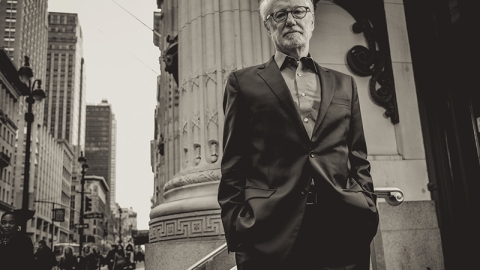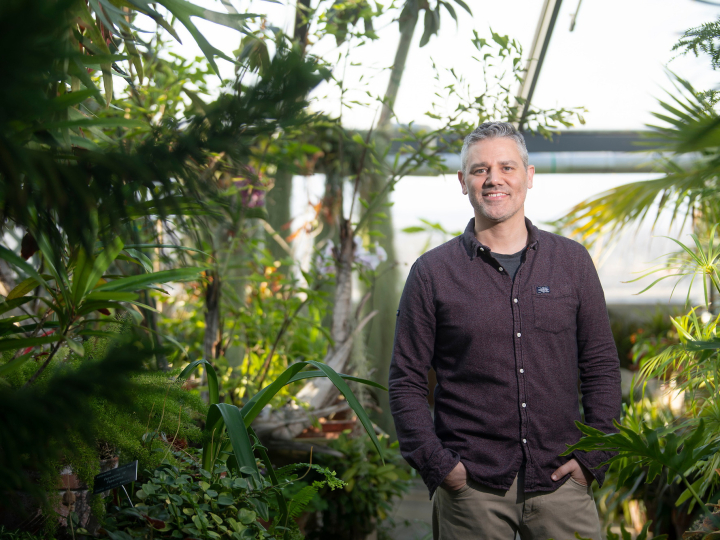
Historian at Heart
April 17, 2015
In his biographies, David Nasaw '67 tells the tales of prominent figures, and in the process shares the stories of the eras in which they lived. You might call him a storyteller or an academic. But he'll always be a historian at heart
By Alexander Gelfand • Illustration by Bill Cardoni
Not many academic historians can boast of having been interviewed by Jon Stewart on The Daily Show, but David Nasaw ’67 can. He appeared before millions of TV viewers to discuss his latest book, The Patriarch, a biography of Joseph P. Kennedy — and in the process publicly debunked the notion that Kennedy made his fortune as a Prohibition-era bootlegger. But Nasaw, who is the Arthur M. Schlesinger Jr. Professor of History at the CUNY Graduate Center and president of the Society of American Historians, is no ordinary academic.
Nasaw enrolled in the graduate program in history at Columbia University just in time to help shut the university down during the student protests of 1968, then took a year off to teach at an alternative high school in an abandoned dry cleaning shop on the Upper West Side of Manhattan, where the curriculum ranged from Marxism to macramé. (To raise funds for the school, Nasaw edited his first book, Starting Your Own High School, the contents of which were written entirely by his students.) After completing his Ph.D., he taught history at a community college on Staten Island before eventually moving to CUNY, where he has served as director of the Center for the Humanities and helped establish the Leon Levy Center for Biography.
Long fascinated by the history of American media and entertainment and the relationship between business, culture and politics, Nasaw has also authored best-selling biographies of three of the most influential figures in 19th- and 20th-century America: media magnate William Randolph Hearst; capitalist and philanthropist Andrew Carnegie; and Kennedy, the businessman-turned-diplomat who sired the nation’s greatest political dynasty. The popularity of those books has made Nasaw a prominent public intellectual, with frequent appearances on radio and television. But it’s clear he remains a historian at heart.
What drew you to history?
DN: I went to Bucknell assuming I would follow my father and go into law. But I met two extraordinary history professors — Richard Drinnon and John Kirkland — and boom! I was off and running.
When I went to Columbia for my Ph.D., I originally intended to study European intellectual history. But I realized that in order to really do that well, I had to be able to read French and understand French culture. That meant living in France for a couple of years, and I wasn’t ready to do that.
My first job was at the College of Staten Island. I was astounded by the growth of two-year schools like the one I was teaching at, and I was trying to figure out how the hell it had happened. Why had the United States created this new institution? Why not simply create more four-year schools? That led to my first book in U.S. history, Schooled to Order.
My next book, Children of the City, came about because I went to a photo exhibit at the New-York Historical Society and saw all of these newsboys captured in photographs from 1890 through 1910. I noticed that all of those newsboys, who were supposed to be homeless, bedraggled waifs, had good shoes. For a historian, photographs are as important as any other kind of evidence, and I knew enough to know that if they were homeless waifs, they wouldn’t have good shoes on their feet! I discovered that they were not homeless waifs, but working-class kids — the children of Jewish and Italian immigrants — kids who went out every afternoon and sold newspapers.
So Children of the City was born of serendipity?
DN: There was a serendipitous encounter with those photographs. But I’m a child of the ’60s, and my generation of historians attempted to do history from the bottom up: Instead of just looking at powerful white men, we tried to give voice to those who had been left out of the story. I wanted to show that these working-class immigrant children also contributed to the making of history, and I wanted to give them agency — to show that they were actors, not simply acted upon. Unbeknownst to me, it became one of the first books in a new history of children.
Both Children of the City and your next book, Going Out, explored the cultural and social environments that shaped the way Americans of a particular era understood the world. It’s almost like a kind of anthropology, isn’t it?
DN: I took a lot of anthropology and sociology at Bucknell and Columbia, and it informed those books.
Too often, history is taught looking for similarities. When we teach elementary-school students, we say, “Oh, in the colonial era, they played with dolls. We play with dolls, too.” But what’s more important than those similarities are the differences.
In doing Children of the City, I became fascinated by the efflorescence of a new type of public institution in the United States between the 1890s and World War I. All of a sudden, out of nowhere, amusement parks, nickelodeons, vaudeville houses — all of these institutions were created where immigrants and working people intermingled with the middle class. They became a real melting pot and a place of Americanization where immigrants learned American manners. But it worked only because African-Americans were excluded from all of these places; the immigrants were taught early on that in order to become American, you had to become white. That became the subject of Going Out.
Your biographies also explore the many factors that influenced your subjects’ behavior, from their family backgrounds to the social and cultural settings in which they operated.
DN: I’m always trying to provide a historical context, and I’m very conscious of the ways in which history makes the person.
We are born and raised in a specific time and place. It’s a cliché, but the past is a foreign country. In order to understand why people do what they do, one has to get as close as possible to understanding that time and that place.
Joseph Kennedy, for example, was very much a product not simply of Boston, but of East Boston. Hearst was the first bicoastal American. Carnegie was even more fascinating, because he lived his life on both sides of the Atlantic — he was a Yankee Doodle Scotsman.
What initially led you to biography?
DN: When I finished Going Out, it was right around the time that Ross Perot was running for the presidency. Perot had personality and a populist platform and all the money in the world, and I wanted to explore the intersection of politics and culture, of electoral politics and the media. And I was going to do that by looking at William Randolph Hearst.
I had no intention of writing a biography. I wanted to write about what happens when one of the richest men in the country, who owns the largest media empire in the country, decides he wants to be president. But the more I learned about Hearst, the more I understood that if I wrote about him, I could write about the 20th century’s major industry: the media. If the 19th century was the age of railroads and electricity, and the 21st century is the age of the computer, then the 20th century was the age of media. They had an impact on politics and on the economy that was second to none.
I also enjoyed that in writing history through biography, I could reach a larger audience. I never wanted to write simply for other professors; from the very beginning, I tried my best to write books that would say something to students, say something to scholars and say something to a larger audience that’s interested in ideas and history and politics.
It’s hard not to draw connections between the historical themes that appear in your biographies and the issues we face today in America: the interpenetration of media and politics, the limits of private philanthropy, the perils of unrestrained capitalism. Do you want your readers to make those connections?
DN: Absolutely. I define myself as a historian, not a biographer. What does that mean? I tell the story. I’m not a judge or a prosecutor who sits in judgment of these people. I tell the story. And when I tell the story well, it brings up questions, and it forces people, I hope, to look at contemporary life, to look at the past and to ask questions. For a historian, a biography is not simply about a person — there are larger themes. In The Chief, I wrote about the making of the American media; in Carnegie, about immigration and the Industrial Revolution.
You’ve written for the popular press and made numerous media appearances. Is that an important part of your scholarly activity — bringing historical insight to a broader public?
DN: I try! I have a very steep lecture fee, so I can do lots of appearances for no fee at all: I’ll speak at a library opening in upstate New York, at a community college or a junior high school. I think the task of the historian is to talk to people who don’t have Ph.D.s without dumbing down what you have to say.
Alexander Gelfand is a writer based in New York. His work has appeared in The New York Times, the Chicago Tribune and The Economist.

